#watling street
Explore tagged Tumblr posts
Photo
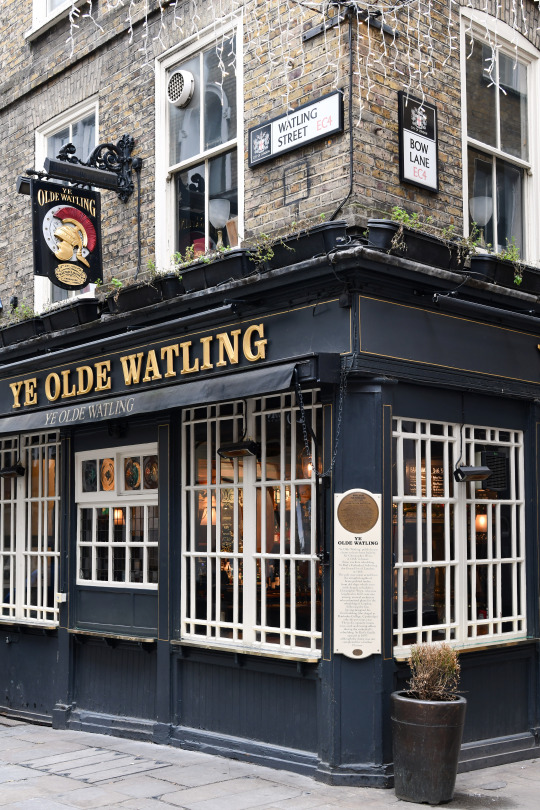
Day 1650, 29 December 2022
#pub#public house#beer#ale#lager#drinking#alcohol#Watling Street#Roman#Roman Road#city of london#london#England#UK
30 notes
·
View notes
Text
Remarkable Discovery of Roman Watling Street in South-East London
Remarkable Discovery of Watling Street in South-East London A remarkably well-preserved section of Watling Street, one of the most significant and renowned Roman roads in Britain, has been unearthed in south-east London. Archaeologists have hailed this discovery as a “remarkable” find, providing invaluable insight into the ancient infrastructure of the Roman Empire in Britain. Originally…
#ancient infrastructure#archaeological discovery#Gillian King#Londinium#Old Kent Road#Roman Empire#Roman roads#South-East London#Southwark Council#Watling Street
0 notes
Text
experiencing the orla emotions (I thought too hard about her and now I need to lie down)
#shes..... shes just so........#I dont know she deserves the world she should get everything#first I listened to slipping through my fingers and thought about her and her dad#and then I rewatched the part with her and her dad at watling street#and then that bit afterwards HER LITTLE FACE WHEN PAULINUS IS TALKING TO ATTI AND WHEN HE'S TAKING HIM AWAY </3#and then it was when I grow up from matilda and#“when I grow up I will be brave enough to fight the creatures that you have to fight beneath the bed each night to be a grown up” and......#then it was fade away by oasis and to honest then I just started to get entertained by the idea of orla being a britpop fan#she would be and she and her dad would listen to britpop together and brenda would hate it#but also “WHEN I WAS YOUNG I THOUGHT I HAD MY OWN KEY I KNEW EXACTLY WHAT I WANTED TO BE NOW I'M SURE YOU'VE BOARDED UP EVERY DOOR”#okay to be fair its midnight I probably should lie down and go to bed but its incoherent orlaposting hours#orla my beloved#horrible histories the movie#horrible histories rotten romans#I will spare hhtv fans from having to endure this one#mercury posting
2 notes
·
View notes
Photo
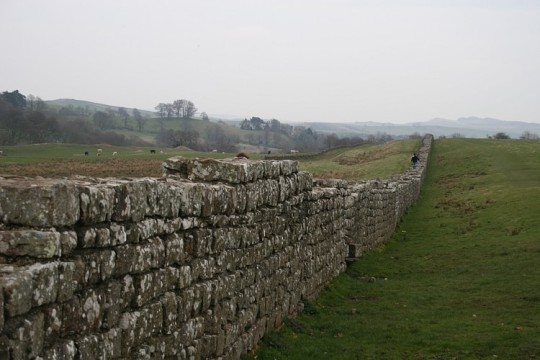
Hadrian's Wall
Hadrian's Wall (known in antiquity as the Vallum Hadriani or the Vallum Aelian) is a defensive frontier work in northern Britain which dates from 122 CE. The wall ran from coast to coast at a length of 73 statute miles (120 km). Though the wall is commonly thought to have been built to mark the boundary line between Britain and Scotland, this is not so; no one knows the actual motivation behind its construction but it does not delineate a boundary between two countries.
While the wall did simply mark the northern boundary of the Roman Empire in Britain at the time, theories regarding the purpose of such a massive building project range from limiting immigration, to controlling smuggling, to keeping the indigenous people at bay north of the wall. The wall continued in use until it was abandoned in the early 5th century CE.
Purpose
The military effectiveness of the wall has been questioned by many scholars over the years owing to its length and the positioning of the fortifications along the route. The argument goes that, had the wall actually been built as a defensive barrier, it would have been constructed differently and at another location. Regarding this, Professors Scarre and Fagan write,
Archaeologists and historians have long debated whether Hadrian's Wall was an effective military barrier…Whatever its military effectiveness, however, it was clearly a powerful symbol of Roman military might. The biographer of Hadrian remarks that the emperor built the wall to separate the Romans from the barbarians. In the same way, the Chinese emperors built the Great Wall to separate China from the barbarous steppe peoples to the north. In both cases, in addition to any military function, the physical barriers served in the eyes of their builders to reinforce the conceptual divide between civilized and noncivilized. They were part of the ideology of empire. (Ancient Civilizations, 313)
This seems to be the best explanation for the underlying motive behind the construction of Hadrian's Wall. The Romans had been dealing with uprisings in Britain since their conquest of the region. Although Rome's first contact with Britain was through Julius Caesar's expeditions there in 55/54 BCE, Rome did not begin any systematic conquest until the year 43 CE under the Emperor Claudius (r. 41-54 CE).
The revolt of Boudicca of the Iceni in 60/61 CE resulted in the massacre of many Roman citizens and the destruction of major cities (among them, Londinium, modern London) and, according to the historian Tacitus (56-117 CE), fully demonstrated the barbaric ways of the Britons to the Roman mind.
Boudicca's forces were defeated at The Battle of Watling Street by General Gaius Suetonius Paulinus in 61 CE. At the Battle of Mons Graupius, in the region which is now Scotland, the Roman General Gnaeus Julius Agricola won a decisive victory over the Caledonians under Calgacus in 83 CE. Both of these engagements, as well as the uprising in the north in 119 CE (suppressed by the Roman governor and general Quintus Pompeius Falco), substantiated that the Romans were up to the task of managing the indigenous people of Britain.
The suggestion that Hadrian's Wall, then, was built to hold back or somehow control the people of the north does not seem as likely as that it was constructed as a show of force. Hadrian's foreign policy was consistently “peace through strength” and the wall would have been an impressive illustration of that principle. In the same way that Julius Caesar built his famous bridge across the Rhine in 55 BCE simply to show that he, and therefore Rome, could go anywhere and do anything, Hadrian perhaps had his wall constructed for precisely the same purpose.
Continue reading...
213 notes
·
View notes
Text

2,000-Year-Old Roman Road Discovered in London
A section of one of Britain’s most important Roman roads has been unearthed in London.
The 2,000-year-old road was discovered under the Old Kent Road in the south-east of the city.
Known as Watling Street, the original road ran from the port of Dover in Kent through London to the West Midlands.
Experts say its the first time that a part of the ancient route has been found intact beneath the modern tarmac surface.



The road was discovered by Southwark Council, during work to expand the area's heating network.
It was then identified as the ancient route by a team of archaeological experts from the Museum of London Archaeology (MOLA).
Southwark Council's archaeology officer Dr Chris Constable said that the scale of the road's survival was "remarkable".
"We hope this project will answer some other archaeological questions in the borough,” he added.
A sign will now be put up on the nearby railway bridge to mark the discovery.


#2000-Year-Old Roman Road Discovered in London#Old Kent Road#ancient artifacts#archeology#archeolgst#history#history news#ancient history#ancient culture#ancient civilizations#roman history#roman empire
30 notes
·
View notes
Note
Hello! I invented the ultimate time machine! But it has some problems, it can go back in time as far as you want, or to the future.
BUT! if you try to go between 1880-1939 it won't allowed you. Same if you want to travel to recent eras, 1995-2023.
Call your favourite character, oc/ship and travel with them across the time (except the aforementioned years.) Let me know where you landed!
You can create a moodboard or only reply tell me, where you are ❤️.
Just press the button.


Battle of Watling Street - 61 CE.
Thomas should’ve hated the girl. Anna Ferrante, the daughter of an influential Roman family who had traveled all the way to Britain to conduct their trade. The daughter of the enemy.
Love was a strange thing.
But she was still a Roman, he was still a Briton. And that was the day he would join Boudica’s forces against the Roman invaders. She had begged him not to go. She had begged him to stay. But he couldn’t step back. Not even for love.
Little did he know, nothing could keep her from staying by his side. Not even war.

Thank you so much for sending this, Flor🥹🤍
This is definitely different from what I usually do! I had a few options in mind, but the fact that this battle probably took place near modern-day Birmingham was what eventually convinced me.
14 notes
·
View notes
Text
The Retired Colourman
Published in 1926, this was placed last in the Case-book compilation, although it was not the last Holmes story Doyle published. That is "Shoscombe Old Place", which we have yet to cover.
A colourman is someone who makes and sell paint. The term is very little used these days.
Lewisham is a London suburb located six miles from Charing Cross; it had transferred from Kent to London in the 1889 creation of the London County Council and today forms its own London Borough.
The Coptic Pope at the time was Cyril V, who reigned from 1874 to 1927, the longest serving head of the Coptic Orthodox Church.
The Theatre Royal Haymarket was opened in 1720 and remains in use today as a theatre. It's currently running a production of Noises Off and next year will play host to The Picture of Dorian Gray, which is going to see Sarah Snook play all 26 roles.
Blackheath is a suburban station today served by electric trains operated by Southeastern from Victoria, Charing Cross and Cannon Street.
Lothario dates back to Don Quixote as a name, but its use for a serial seducer of women comes from the 1703 Nicholas Rowe play The Fair Penitent.
Crockford's Clerical Directory is a book listing clergy in the UK and Ireland.
Little Purlington is fictitous, but Frinton is real. Now Frinton-on-Sea, it is located on the Essex coast and by 1927 was attracting regular high society visitors. Former residents of note include Deborah Watling, who played Victoria Waterfield in Doctor Who. Due to its reputation as a place to retire to, it became the subject of a common joke "Harwich for the Continent, Frinton for the incontinent", the former being an LNER advertising slogan. Probably not a good idea to make that gag locally though.
Third Class trains had originally been ones with wooden seating, but by this time, Second Class had been abolished and the former passengers were now generally in upholstered carriages. Third Class became Second Class in 1956 on British Railways and is now Standard Class.
I have been unable to find when cyanide pills became a thing. Doing a search for them gives you the number of a suicide prevention line first, which is quite reasonable.
Broadmoor is a high-security psychiatric hospital in Berkshire, completed in 1863. Notable patients have included Ronald 'Ronnie' Kray, 'Yorkshire Ripper' Peter Sutcliffe and Edward Oxford, a barman who tried to kill Queen Victoria. Until 2018, it maintained sirens to be used in case of an escape.
29 notes
·
View notes
Text
“A third of the UK is owned by 1,200 aristocrats and their families. Thirty-six thousand people, or 0.6 per cent of the population, own half of the rural land in England. Despite the widely held belief that Britain is ‘full’ and that it is in danger of being ‘concreted over’, only 6 per cent of the UK’s land use is classed as urban, with 94 per cent rural.” John Higgs, Watling Street: Travels Through Britain and Its Ever-Present Past
6 notes
·
View notes
Text
Cassarian
Yes, I'm giving Cassarian some love again - for a big project coming in December
7 notes
·
View notes
Text
London-Holyhead Mail in Anglesey
The very earliest "Mail" system started during the reign of Henry VIII taking official documents from London via Chester and the coast road to the port of Holyhead. This was crucial for maintaining communication between the English court and officials in Wales and Ireland. The post road ran over Lavan Sands and through Beaumaris at first, and thus it was in 1675 when John Ogilby made a map of it. Later its line was changed a little, the post road ceased to cross Lavan Sands, and went from the Porthaethwy Ferry through Penmynydd.
Various Postmasters were appointed a stages along the route who had to supply the horses for the Royal Messenger and a Postboy to show him the way and return the horses from the next staging post. The Post Masters were often Innkeepers. By the time of Charles I demand was such from the public that the Royal Mail was made available to all, or at least those who could afford to pay. When a public postal service was first introduced along these routes in 1635, letters were carried between ‘posts’ by mounted post-boys and delivered to the local postmaster. The postmaster would then take out the letters for his area and hand the rest to another post-boy to carry them on to the next ‘post’. This was a slow process and the post-boys were an easy target for robbers, but the system remained unchanged for almost 150 years.
In 1720, one Ralph Allen from Bath took contracts for parts of this system, made it more efficient, and made a lot of money.
The next stage of development came with John Palmer, also from Bath, who persuaded the then Chancellor William Pitt that it would be a good idea to carry the Mail by stagecoach. Safer also as the Postboys were always at risk of attack. Although the Post Office were against the idea, Palmer went ahead on his own and developed a network of routes to carry the Mail by specially designed coaches. The London Holyhead route was one such. In 1785 the Post agreed to take over the running of the service. Each Mail coach had priority on the route, paid no Turnpike dues and the Mail was protected by an armed Royal Mail Guard. Mail Coaches left the Swan with Two Necks Inn in London promptly at 8.00pm every evening and arrived at Holyhead 45.5 hours later. Nantwich and Tarporley were stopping points for the team of four horses to be changed as was Chester but there the stop included a meal break.
Over time the route was changed to miss out the dangerous crossing of the River Conway and the mountainous North Wales coast to an easier one via Shrewsbury thus the Mail coaches no longer came through Cheshire. It also shortened the journey to about 25 hours.
The Act of Union 1800, which unified Great Britain and Ireland, gave rise to a need to improve communication links between London and Dublin. A parliamentary committee led to an Act of Parliament of 1815 that authorised the purchase of existing turnpike road interests and, where necessary, the construction of new road, to complete the route between the two capitals. This made it the first major civilian state-funded road building project in Britain since Roman times. Responsibility for establishing the new route was awarded to the famous engineer, Thomas Telford.
Through England, the road largely took over existing turnpike roads and mainly following the route of the Anglo-Saxon Wæcelinga Stræt (Watling Street), much of which had been historically the Roman road. However Telford's Holyhead Road leaves Watling Street, picking up instead the major cities of Coventry, Birmingham, and Wolverhampton; this routing being far more useful for communications. The London-Holyhead Mail Coach then ran along the A5 until the introduction of the railways later in the nineteenth century.
0 notes
Text
A RE-ENVISIONING OF HIS GRACE KING ALFRED OF ANGLIA'S CYRCE WITH KING GUTHRUM OF THE DANES
ALFRED: Shall loam all ache and sorrows cease? No! 'Tis only Shalom which all aches and sorrows ceases!
GUTHRUM: We would have land. But I will entertain your bog-water magic.
ALFRED: Do not! Tarnish!—our...not magic! It is the Holy Sacrament…of Baptism.
GUTHRUM: Oh come now, Alfred…even we kings are given to superstition. But I will blive in the will of the gods.
ALFRED: There is only one God you will serve now.
GUTHRUM: As it has always been for me. You have your archangels. We our lesser gods. But the All-Father is supreme.
ALFRED: 'Thou shalt have no other gods before me." Thus saith the lord. It is the first commandment.
GUTHRUM: The war is barely over and already you make commands. Does this Christ-god's father who is also yours even not admit in his commandment that the other gods are just as real?
ALFRED: "They sacrificed to false gods, which are not God." GUTHRUM: I have studied your runes and... ALFRED: "Oft, though their hearts lean towards one another,
friends are divided at table..." GUTHRUM: It would seem you have læsed mine as well. How did you come to the Havamal? ALFRED: In foresight. In hind I found you more intimidating enemies before reading it. Better a brodor than a byrden. Brothers I can manage. Brothers to kings—brother kings, in my case—are a mite more difficult. But hardly as difficult as a northman laying claim to land for which he has not shed blood.
GUTHRUN: Then perhaps you should think of me only as a brother in your Christ-god fellowship. Is his blood not enough to bring me into the fold? ALFRED: Ah, yes, I can smell the heathen burning off as the spirit descends; do you feel it? Just…there. GUTHRUM: And now you would allow me setl at the beod til...
ALFRED: Yes, even then you…are welcome at the table. For even now you are already are what you are to become. I avow it.
King Alfred the Great King Guthrum Roman Watling Street at Wessex Anno Domini 886
ᛊᛝᛞ | soling dae
0 notes
Text
How to Find The Waggon and Horses, a Hidden Gem among Pubs in Radlett
Imagine a quaint village nestled in the heart of Hertfordshire, where tradition meets modernity, and the pub culture is alive and thriving. Radlett, with its picturesque landscapes and charming streets, is home to one hidden gem that stands out among the pubs — the Waggon and Horses.
Introduction
Radlett, often hailed for its idyllic setting and vibrant community, boasts a variety of pubs catering to different tastes. Among them, the Waggon and Horses holds a unique place, offering an experience that goes beyond the ordinary.
History of the Waggon and Horses

Unique Features of the Pub
Architectural Charm
One of the defining features of the Waggon and Horses is its timeless architectural charm. The building, with its historical significance, provides a warm and inviting atmosphere that transports visitors to a bygone era.
Special Events and Traditions
Beyond the regular pub scene, the Waggon and Horses stands out for its special events and traditions. From seasonal celebrations to unique themed nights, there’s always something exciting happening at this hidden gem.
Notable Clientele

Locating the Waggon and Horses
To embark on this unique experience, finding the Waggon and Horses is the first step. Conveniently located in the heart of Radlett, the pub’s address and contact information make it easy for curious patrons to plan their visit.
Address and Contact Information
Address: Watling St, Elstree, Radlett, Borehamwood WD6 3AA, United Kingdom
Phone: +44 7360 498666
Accessibility and Parking

Ambiance and Decor
Step inside, and you’re greeted by an ambiance that seamlessly blends tradition with contemporary comfort. The interior design of the Waggon and Horses reflects the pub’s commitment to providing a cozy and welcoming space.
Interior Design
The classic pub aesthetics are complemented by thoughtful decor, creating an environment that encourages socializing and relaxation. Whether you prefer intimate corners or lively communal spaces, the Waggon and Horses has it all.
Outdoor Seating Areas

Menu Highlights
A pub experience is incomplete without delectable offerings, and the Waggon and Horses excel in this aspect. The menu features a variety of dishes and drinks that cater to different tastes.
Signature Dishes and Drinks
From classic pub fare to innovative culinary delights, the Waggon and Horses take pride in its signature offerings. Indulge in a gastronomic journey that reflects the pub’s commitment to quality.
Dietary Options and Specialties

Local Reviews and Recommendations
The true measure of a pub’s excellence lies in the feedback from its patrons. The Waggon and Horses has garnered praise from both customers and the local press.
Customer Testimonials
“Been here a few times and with every visit it has gotten better. The waitress who served us today (Wendy) was absolutely brilliant, it seemed that she really enjoyed her job and did it with passion. She deserves a raise. Definitely coming back again. Burger was 10/10. The beer garden is fantastic in summer.!” — Tereza Mateju
Positive Press Coverage
The pub has also caught the attention of local publications, earning positive reviews for its commitment to quality and community engagement.
Upcoming Events and Activities
A dynamic pub experience involves more than just the usual. The Waggon and Horses ensures a calendar filled with events and activities to keep patrons coming back for more.
Regular Events
From quiz nights to live music performances, the Waggon and Horses has a lineup of regular events that add excitement to any visit.
Special Promotions and Themed Nights

Staff and Service
The Waggon and Horses prides itself on not just its physical space but also the people who make it come alive. The staff’s friendly demeanor and commitment to excellent service contribute to the pub’s welcoming atmosphere.
Friendly Atmosphere
From the moment you walk in, the staff ensures a friendly atmosphere, making you feel right at home.
Customer Service Excellence
Prompt and attentive, the service at the Waggon and Horses is a testament to the pub’s dedication to customer satisfaction.
Waggon and Horses in the Digital Age
In today’s digital landscape, a pub’s online presence is as crucial as its physical one. The Waggon and Horses keep pace with the times, ensuring a strong digital footprint.
Social Media Presence
Stay updated on the latest events and offerings through the pub’s active social media channels.
Online Reviews and Ratings

Comparison with Other Pubs in Radlett
Radlett may have several pubs, but the Waggon and Horses stand out with its unique selling points and differentiating factors.
Unique Selling Points
Whether it’s the historical charm, diverse menu, or community engagement, the Waggon and Horses offers something that sets it apart.
Differentiating Factors
A comparison with other pubs in Radlett reveals the distinct features that make the Waggon and Horses a preferred choice for many.
Conclusion
In conclusion, the Waggon and Horses is more than just a pub; it’s a destination where history, community, and excellent service converge. Whether you’re a local resident or a visitor to Radlett, this hidden gem promises an experience that transcends the ordinary pub outing. Plan your visit to the Waggon and Horses and immerse yourself in the charm of this Radlett treasure.
Get Access Now
For more information and to plan your visit, click here.
0 notes
Text
Heroínas
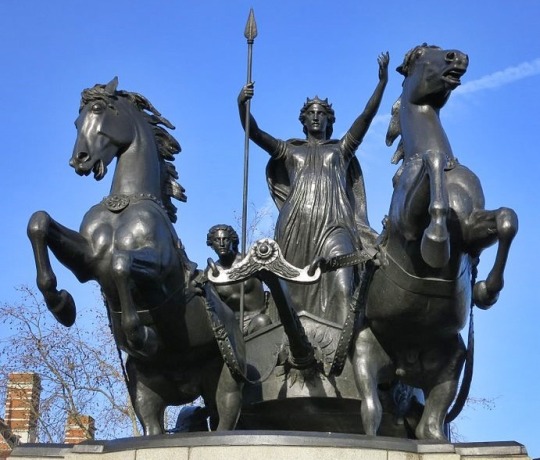
Boudica
Boudica foi rainha da tribo britânica Iceni, que liderou uma revolta fracassada contra as forças do Império Romano em 60 ou 61 d.C.
Boudica era a esposa do rei Prasutagus que governou suas terras como um aliado independente de Roma e que, portanto, deixou sua propriedade dividida entre o imperador Nero e a esposa e duas filhas. Após sua morte, no entanto, as terras icenas foram usurpadas por Roma, Boudica foi açoitada e suas filhas foram estupradas pelos romanos por ousarem presumir que tinham direitos que deveriam ser reconhecidos por Roma.
Boudica rapidamente reuniu sua tribo e atacou três cidades, resultando em mais de 80.000 cidadãos romanos massacrados. Boudica foi derrotada na Batalha de Watling Street em 61 d.C. por Suetônio, que criteriosamente escolheu o local da batalha para favorecer seu menor número.
Uma estátua de Boudica e suas filhas foi concluída em 1905, encomendada pelo príncipe Alberto como presente para a rainha Vitória, admiradora de Boudica. A estátua fica perto da Casa do Parlamento e da Ponte de Westminster, em Londres.
Boudica é considerada uma heroína nacional britânica e um símbolo da luta por justiça e independência.
-> Estátua de Boudica em Londres, Inglaterra
~*~
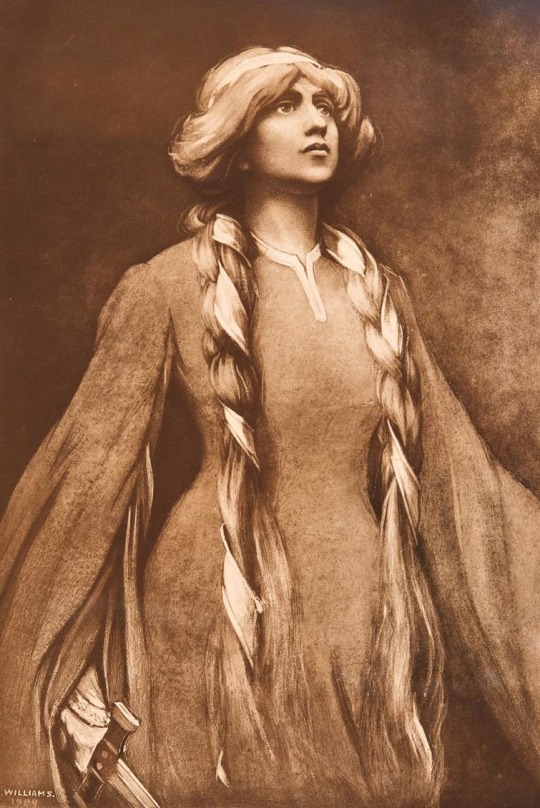
Gwenllian ferch Gruffydd
Gwenllian ferch Gruffydd foi uma princesa galesa que liderou um exército na batalha contra os normandos.
Gwenllian ferch Gruffydd era casada com Gruffydd ap Rhys, Príncipe de Deheubarth. Dizia-se que ela tinha uma grande beleza, era inteligente e bem educada. Gwenllian viveu em tempos conturbados, pois os senhores galeses perderam muitas de suas posses para os normandos após a invasão da Inglaterra por Guilherme, o Conquistador, em 1066. Como havia recebido treinamento militar, Gwenllian lutou ao lado de seu marido. Ela e Gruffydd lideraram ataques a assentamentos estrangeiros tomando bens e dinheiro para redistribuir entre os galeses que foram despossuídos por esses colonizadores, como um par de "Robin Hoods de Gales".
Enquanto seu marido estava em Gwynedd buscando uma aliança com seu pai, os anglo-normandos fizeram ataques e Gwenllian assumiu o comando do exército. Em uma batalha um de seus filhos foi morto e ela e seu outro filho foram capturados e executados. A notícia da morte de Gwenllian e seus filhos enfureceu os senhores galeses, que rapidamente se juntaram à rebelião.
As ações de Gwenllian foram comparadas com as de outra líder celta: Boudica. O campo onde se acredita que a batalha tenha ocorrido, é conhecido como Campo de Gwenllian e por séculos depois, os galeses usaram "Vingança por Gwenllian!" como um grito de guerra
Hoje em dia algumas pessoas acreditam que Gwenllian pode ter sido a autora dos Quatro Ramos dos Mabinogi, as primeiras histórias em prosa na literatura da Grã-Bretanha.
1 note
·
View note
Text
the writers of the horrible histories movie: and then orla decided she didn’t want to fight anymore so she decided not to take the sword when her dad said she could have it
everyone who watched the movie: no I don’t think she did do that
look in my opinion, it makes sense as a short term decision following literally everything that happened at watling street but I can’t imagine it being something she stands by for longer than like a couple months at most, I also think they definitely just did that because they can’t really endorse violence to children
#horrible histories the movie#orla my beloved#horrible histories rotten romans#horrible histories#mercury posting
4 notes
·
View notes
Text

Archaeologists Find Statue of the Roman Sea God Triton in Mausoleum
Archaeologists have uncovered a Roman Statue of Triton during excavations in preparation for a housing development in Kent, England.
Archaeologists from the Canterbury Archaeological Trust (CAT) have discovered artifacts, including a mausoleum which is to be buried within a roundabout, which are more than 1,700 years old during an investigative dig related to a new housing development close to London Road in Teynham.
Robert Masefield, Director for RPS, said: “We expected interesting Roman archaeology, perhaps a cemetery, but the finds including the lively and unique statue of a Triton and the mausoleum remains have by far exceeded that. These finds are now part of Teynham’s local legacy and the nations rich Roman story. Further study will place the findings in their full historical context.”
The area, which is being built on by Moat Homes and Chartway Partnerships Group for its Frognal Lane development, follows the ancient Roman Watling Street and during an initial site evaluation, fragments of chalk wall foundations and Roman cremation burials were discovered. As a result, Swale Council, with advice from Kent County Council Heritage Conservation, required a 0.5-hectare archaeological excavation at the site.

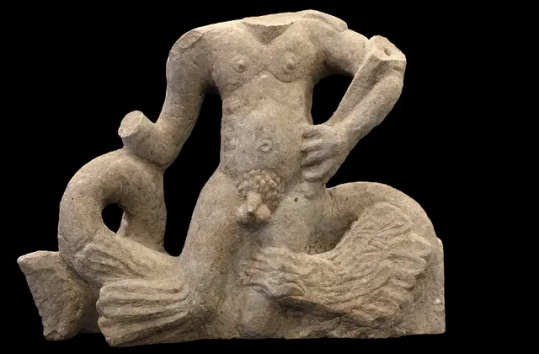

The Canterbury Archaeological Trust (CAT) was tasked with leading the dig, which revealed elements of a 30m square walled enclosure surrounding a c.7m square structure. Further excavations revealed that the structure is a Roman mausoleum containing a Roman coin dating from around 320 to 330 AD. The site also included Roman, and possibly later, burials with various grave goods.
However, the highlight of the findings was the discovery of a stone statue, representing the sea god Triton.
The Triton statue is substantial, appropriately 70cm (27.5 inches tall) and 70cm wide. It weighs more than 132lb (60kg). Archaeologists did not need to dig far. It was only 1.3 feet (40cm) below ground.
In Roman mythology, Triton was the son of Neptune, the god of the sea. The unique stone statue depicts Triton – a merman with the torso of a man and the tail of a fish – riding on a sea monster.
As a demi-god, he could calm the waves by blowing on his conch shell, which he appears to be holding in the uncovered sculpture. That part has been broken off, but the artifact is otherwise in incredible condition. It was carved between the late first century and second century AD.
Dr. Richard Hobbs, senior curator of Roman Britain at the British Museum, told MailOnline it is ‘spectacular’.
He said that, although a few fragments of Triton sculptures are known from Roman Britain, ‘nothing quite like this has been discovered before’.
Excavations are continuing at the site.
By Leman Altuntaş.
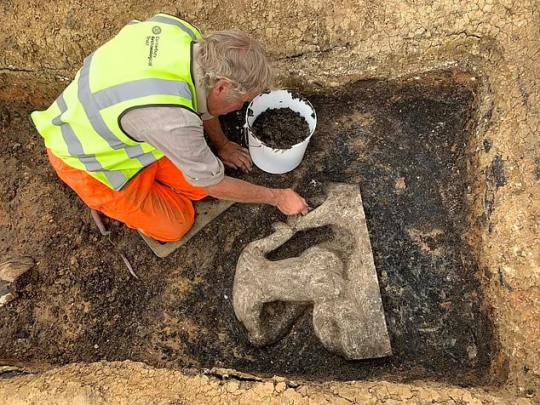
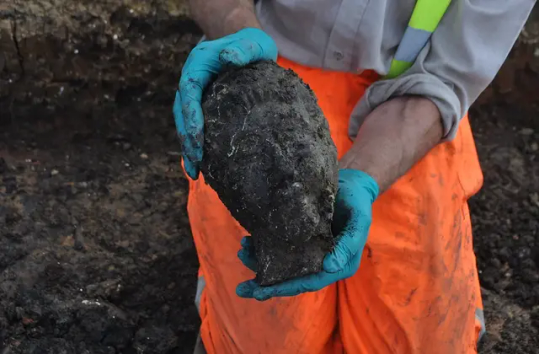

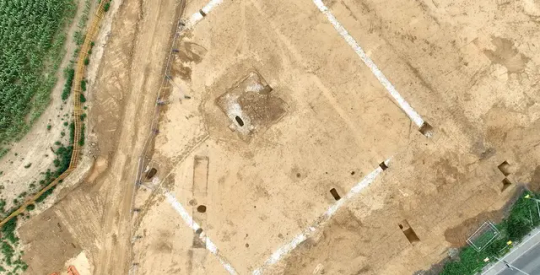
#Archaeologists Find Statue of the Roman Sea God Triton in Mausoleum#Kent England#The Canterbury Archaeological Trust#stone statue#roman statue#ancient tomb#ancient grave#ancient mausoleum#ancient artifacts#archeology#archeolgst#history#history news#ancient history#ancient culture#ancient civilizations#roman history#roman empire#roman art
221 notes
·
View notes
Text
Home
We are located in Camden, Holborn close to Westminster W1 near Soho, London
Our address is: 8F Gilbert Place, Holborn (next door to Bloomsbury), London, WC1A 2JD. About Camden: Lincoln's Inn Fields is a neighbourhood in the extreme south of the borough that is only 500 metres from the Thames. The northern part of the borough is home to Kentish Town, Hampstead, and Hampstead Heath, which are less populous districts. Numerous parks and open areas may be found in the London Borough of Camden. City of Westminster (near Soho, London) and the City of London are the next-door boroughs, followed by Brent to the west of what was once Roman Watling Street (now the A5 Road), Barnet and Haringey to the north, and Islington to the east. It encompasses all or a portion of the following postcode areas: N1, N6, N7, N19, NW1, NW2, NW3, NW5, NW6, NW8, EC1, WC1, WC2, W1, and W9. The borough of Camden also includes Bloomsbury, known for its garden squares. To the west, the fashionable district of Marylebone is rich in shops and restaurants, while the prestigious Mayfair extends slightly into Camden. Covent Garden, famed for its entertainment and market, adds to Camden's vibrancy. Bordering the east of the borough are Clerkenwell and Farringdon, hubs for the design industry and renowned for their mix of old and new architecture. Although Lambeth and South Bank are located south of the Thames and not within Camden, they contribute to the broader cultural scene that Camden residents can easily access. To the east of Camden, beyond Islington, lies the diverse and bustling borough of Hackney, which provides a distinct cultural blend of its own. Wimpole Street and Harley Street (very close to Camden) are famous for the high number of private health care providers, especially dentists.
Originally published here: https://forestray.dentist/
0 notes